Water and Nitrogen Balance under Various Water and Fertilizer Regulation Modes
Abstract
:1. Introduction
2. Materials and Methods
2.1. Overview of the Study Area
2.2. Experimental Design
2.3. Sample Collection and Analysis
2.3.1. Observation of Water Balance Elements and Determination of Water Samples
2.3.2. Determination of Nitrogen Content in Plant
2.3.3. Testing of Soil Physical and Chemical Properties
2.3.4. Sampling and Determination of Ammonia Volatilization
2.3.5. Data Processing
3. Results and Discussion
3.1. Analysis of Water Balance of Paddy Fields
3.2. Nitrogen Balance Process in Paddy Field
3.2.1. Nitrogen Wet Deposition
3.2.2. Nitrogen Loss in Surface Water and Seepage Water
3.2.3. Denitrification Process in Paddy Field
3.2.4. Variations in Ammonia Volatilization in Paddy Field
Changes in Ammonia Volatilization Rate at Different Growth Stages
Changes in Ammonia Volatilization at Different Growth Stages
3.2.5. Nitrogen Uptake and Utilization of Rice
Changes in Nitrogen Uptake by Plant Samples at Different Growth Stages
Nitrogen Uptake by Rice
Relationship between Rice Yield and Nitrogen Utilization
3.2.6. Nitrogen Fertility Change in Paddy Soil
3.2.7. Nitrogen Balance in Paddy Field
4. Conclusions
- (1)
- The irrigation pattern had significant effects on the amount of irrigation, drainage and seepage. Compared to the flooding irrigation mode, the intermittent irrigation mode could reduce the amount of irrigation, drainage and seepage.
- (2)
- The nitrogen loss from surface water mainly occurred in the return green stage, early tillering stage and jointing and booting stage. Compared with the flooding irrigation, the total nitrogen (TN) of surface and leakage loss decreased under the intermittent irrigation. Compared to the conventional fertilization, surface and leakage nitrogen emission loads were reduced under the treatment of N1.
- (3)
- The denitrification potential was greater than the nitrification potential during the rice growing season, indicating that soil denitrification was the dominant process in paddy fields. The rate of ammonia volatilization reached its peak 1–3 days after fertilization, and gradually decreased within 3–7 days. The peak value of the ammonia volatilization rate and the maximum loss mainly occurred in the early and middle stages of rice. Under the same irrigation mode, the higher the application of nitrogen, the greater the ammonia volatilization loss. Under the same nitrogen application level, the intermittent irrigation could increase ammonia volatilization compared with the flooding irrigation.
- (4)
- The ratio of stem nitrogen uptake to total nitrogen uptake in rice plants showed a downward trend as the growth period progressed. After the heading stage, the uptake of nitrogen from stems and leaves gradually shifted to the panicle. The nitrogen uptake of rice plants under the intermittent irrigation mode of W1 was higher than that under the flooding irrigation mode of W0. The nitrogen uptake of rice plants under the conventional treatment of N2 increased compared with the treatment of N1.
- (5)
- Intermittent irrigation and reduced fertilization could reduce nitrogen loss from the paddy field surface and plough layer. Among the nitrogen output items, the highest nitrogen output was crop absorption; crop absorption was greater than field drainage, field drainage was greater than ammonia volatilization and ammonia volatilization was greater than denitrification. The ratio of the crop absorption to drainage loss to gas loss was 7:2:1.
- (6)
- The optimal water and fertilizer regulation mode, considering water saving, pollution control, emission reduction and nitrogen conservation, was W1N1, which can save water by 27.54%, reduce emissions by 25.67%, improve the fertilizer utilization ratio by 8.59% and increase yield by 11.82% on average, compared with the traditional mode of W0N2.
Author Contributions
Funding
Data Availability Statement
Conflicts of Interest
References
- Cui, J.; Ma, Y.H.; Zhao, Y.P.; Dong, J.J.; Shi, R.G.; Huang, W.X. Characteristics and prevention and control countermeasures of agricultural non-point source pollution. Chin. Agric. Sci. Bull. 2006, 1, 335–340. [Google Scholar]
- Li, T.T.; Feng, Y.F.; Zhu, A.; Huang, J.; Wang, H.; Li, S.Y.; Liu, K.; Peng, R.M.; Zhang, H.L.; Liu, L.J. Effects of main water-saving irrigation methods on root morphology and physiology of rice. Chin. J. Rice Sci. 2019, 33, 293–302. [Google Scholar]
- Yan, J.; Wu, Q.X.; Zhu, J.Q.; Zhang, L.P.; Li, J.F. Experimental study on nitrogen fertilizer operation research based on water control and emission reduction in paddy field. J. Soil Water Conserv. 2018, 32, 229–236+245. [Google Scholar]
- Geng, F.; Liu, L.H.; Ou, Y.W.; Zhu, J.Q. Characteristics of hydrological and nitrogen loss in typical single-crop rice fields in the Yangtze River Basin. J. Agro-Environ. Sci. 2023, 42, 132–141. [Google Scholar]
- Liu, X.H.; Lu, J.; Qi, Y.; He, Q.; Gao, W.D.; Chen, Y.F.; Hu, A.Y.; He, J.Q. Effects of water-nitrogen coupling on nitrogen uptake, utilization and migration transformation of crops. J. Irrig. Drain. 2022, 41, 1–12. [Google Scholar]
- Cui, Y.L.; Li, Y.H.; Lv, G.A.; Sha, Z.Y. Nitrogen transport and transformation law of rice under different water and fertilizer conditions. Adv. Water Sci. 2004, 280–285. [Google Scholar]
- Okubo, M.; Furukawa, Y.; Sakuratani, T. Growth, flowering and leaf properties of pear cultivars grafted on two Asian pear rootstock seedlings under NaCl irrigation. Sci. Hortic. 2000, 85, 91–101. [Google Scholar] [CrossRef]
- Wang, J.; Lv, G.A.; Guo, X.S.; Wang, Y.Q.; Ding, S.W.; Wang, D.Z. Conservation tillage and optimized fertilization reduce winter runoff losses of nitrogen and phosphorus from farmland in the Chaohu Lake region, China. Nutr. Cycl. Agroecosystems 2015, 101, 93–106. [Google Scholar] [CrossRef]
- Zhang, Z.G.; Wang, J.; Huang, W.B.; Chen, J.L.; Wu, F.Q.; Jia, Y.Y.; Han, Y.C.; Wang, G.P.; Feng, L.; Li, X.F.; et al. Cover crops and N fertilization affect soil ammonia volatilization and N2O emission by regulating the soil labile carbon and nitrogen fractions. Agric. Ecosyst. Environ. 2022, 340, 108188. [Google Scholar] [CrossRef]
- Liu, H.J.; Guo, Z.; Zheng, J.C.; C, L.G.; Zhang, Y.F.; Tong, H.Y. Effects of nitrogen fertilizer reduction on rice yield and nitrogen loss in Taihu Lake area. Chin. J. Ecol. 2017, 36, 713–718. [Google Scholar]
- Wang, Q.; Xu, J.M.; Jiang, L.N.; Lin, H.; Fu, J.R.; M, J.W. Effects of rotational rice on soil nitrification and nitrogen volatilization in greenhouse soil. J. Soil Water Conserv. 2017, 31, 186–190+196. [Google Scholar]
- Wang, Y.Y.; Xia, L.L.; Cai, S.Y.; Zhao, X.; Yan, X.Y.; Xing, G.X. After-effects and destination of residual chemical fertilizer nitrogen in rice-wheat rotation farmland under long-term non-application of nitrogen fertilizer. J. Soil Sci. 2022, 59, 1626–1639. [Google Scholar]
- Xiao, M.H.; Li, Y.Y.; Wang, J.W.; Hu, X.J.; Wang, L.; Miao, Z.M. Study on the Law of Nitrogen Transfer and Conversion and Use of Fertilizer Nitrogen in Paddy Fields under Water-Saving Irrigation Mode. Water 2019, 11, 218. [Google Scholar] [CrossRef]
- Mao, Z. Water-saving Irrigation of Rice. China Rural. Water Hydropower 1997, 45–47. [Google Scholar]
- Huang, M.Y.; Lv, X.J.; Dong, Q.B.; Li, H.; Gao, D.C. Characteristics of atmospheric nitrogen and phosphorus wet deposition and estimation of lake load in Erhai. Yangtze River 2022, 53, 68–73. [Google Scholar]
- Gao, R.; Han, H.H.; Cui, Y.L.; Wang, S.P.; Huang, Y.; Zhang, L. Effects of rainfall on nitrogen and phosphorus wet deposition flux and concentration in rice season in Erhai River Basin. Trans. Chin. Soc. Agric. Eng. 2018, 34, 6–7. [Google Scholar]
- Zhou, S.L.; Sun, Y.; Huang, T.L.; Zhan, J.; Wang, H.; Li, Z.X. Characteristics of atmospheric wet deposition nitrogen, phosphorus and dissolved organic matter in Zhoucun Reservoir. Water Resour. Prot. 2020, 36, 52–59. [Google Scholar]
- Chen, F.J.; Chen, C.Q.; Zhou, F.X.; Lao, Q.B.; Zhu, Q.M.; Zhang, S.W. Study on nutrient salts in atmospheric wet deposition in Zhanjiang Bay. China Environ. Sci. 2017, 37, 2055–2063. [Google Scholar]
- Li, X.L.; Xu, H.; Cai, Z.C. Research progress on the influence of water management on nitrous oxide emissions in paddy fields. Soil 2009, 41, 1–7. [Google Scholar]
- Shao, G.C.; Cui, J.T.; YU, S.E.; Lu, B.; Brian, B.J.; Ding, J.H.; She, D.L. Impacts of controlled irrigation and drainage on the yield and physiological attributes of rice. Agric. Water Manag. 2015, 149, 156–165. [Google Scholar] [CrossRef]
- Peng, S.Z.; He, Y.P.; Yang, S.H.; Xu, J.Z. Effect of controlled irrigation and drainage on nitrogen leaching losses from paddy fields. Paddy Water Environ. 2015, 13, 303–312. [Google Scholar] [CrossRef]
- Jiang, P.; Liu, M.; Qin, J.; Xiong, H.; Xu, F.X. Effect of nitrogen application rate on yield and rice quality of super hybrid rice. China Rice 2017, 23, 102–106. [Google Scholar]
- Cai, Y.J.; Ding, W.X.; Xiang, J. Influencing factors and mechanism of N2O and NO emission from farmland soil. Soil 2012, 44, 881–887. [Google Scholar]
- Erich, M.S.; Bekerie, A.; Duxbury, J.M. Activities of Denitrifying Enzymes in Freshly Sampled Soils1. Soil Sci. 1984, 138, 25–32. [Google Scholar] [CrossRef]
- Chen, Z.G.; Liu, L.M.; Chen, L.; Zhou, X.H. Effects of water regulation on denitrification in rhizosphere soil of rice. Res. Soil Water Conserv. 2015, 22, 133–137+145. [Google Scholar]
- Chen, Z.G.; Chen, L.; Chen, H.X.; Zhou, X.H.; Liu, L.M. Response of denitrase activity to water regulation in rice rhizosphere soil. Environ. Sci. Technol. 2014, 37, 21–25. [Google Scholar]
- Shi, M.; Zhang, W.G.; Li, J.Y.; Yan, S.H.; Gao, Y. Research progress on the effect of elevated CO2 concentration on nitrification and denitrification in water. Chin. J. Appl. Ecol. 2018, 29, 4239–4247. [Google Scholar]
- Wan, Z.W.; Li, N.; Huang, G.Q.; Xu, H.F. Effect of fertilization on denitrification potential of red soil in dryland. J. Huazhong Agric. Univ. 2022, 41, 137–142. [Google Scholar]
- Peng, S.Z.; Yang, S.H.; Xu, J.Z. Ammonia volatilization loss and influencing factors in water-saving irrigation paddy field. Trans. Chin. Soc. Agric. Eng. 2009, 25, 35–39. [Google Scholar]
- Wang, J.B.; Wu, G.; Yuan, Y.; Jing, Y.D.; Wang, W.J.; Zhang, X.M.; Sun, Y.X. Effects of different nitrogen application rates and nitrogen application methods on ammonia volatilization and nitrogen fertilizer utilization efficiency in paddy fields. Soil Fertil. Sci. China 2022, 5, 10–17. [Google Scholar]
- Sommer, S.G.; Olesen, J.E.; Christensen, B.T. Effects of temperature, wind speed and air humidity on ammonia volatilization from surface applied cattle slurry. J. Agric. Sci. 1991, 117, 91–100. [Google Scholar] [CrossRef]
- Nastri, A.; Toderi, G.; Bernati, E.; Govi, G. Ammonia volatilization and yield response from urea applied to wheat with urease (NBPT) and nitrification (DCD) inhibitors. Agrochimica 2000, 44, 231–239. [Google Scholar]
- Yang, G.Y.; Guo, Z.; Liu, H.J.; Wang, X.; Chen, L.G. Research progress on influencing factors of ammonia volatilization in paddy fields and its emission reduction measures. Ecol. Environ. Sci. 2020, 29, 1912–1919. [Google Scholar]
- Lu, L.L.; Wu, G.Y. Research progress on influencing factors of ammonia emission from farmland. J. China Agric. Univ. 2019, 24, 149–162. [Google Scholar]
- Li, R.; Cai, W.W.; Ai, T.C.; Shen, H.P.; Wu, H.L.; Wang, B.; LI, R.N. Variation of ammonia volatilization loss in paddy field and response of rice yield to different water and nitrogen treatment. Soil Fertil. Sci. China 2020, 3, 47–54. [Google Scholar]
- Wu, G.; Yuan, Y.; Cao, Z.W.; Zhang, Z.D.; Wang, L.L.; Wang, Y.L.; Sun, Y.X. Characteristics of ammonia volatilization loss in paddy fields under different water and nitrogen management conditions. J. Ecol. Rural. Environ. 2019, 35, 651–658. [Google Scholar]
- Yu, S.; Cui, Y.L.; Han, H.H.; Liu, F.P.; Xu, Y.Q. Changes of ammonia volatilization in paddy fields under different water and fertilizer systems. J. Irrig. Drain. 2015, 34, 1–5. [Google Scholar]
- Chen, Z.; Cui, Y.L.; Liu, F.P.; Wang, Y. Effects of different irrigation and fertilization modes on physical properties of paddy soil. J. Irrig. Drain. 2013, 32, 38–41. [Google Scholar]
- Cui, Y.L.; Xu, Y.Q.; Zhao, S.J.; Liu, F.P.; Dong, B. Water Saving and Emission Reduction Technology and Application in Southern Rice Irrigation Area; Science Press: Wuhan, China, 2015. [Google Scholar]
- Tian, Y.C.; Cao, W.X.; Wang, S.H.; Zhu, Y. Variation characteristics of water and nitrogen content and photosynthetic rate at different leaf positions of rice under different water and nitrogen conditions. Acta Crops Sin. 2004, 1129–1134. [Google Scholar]
- Liu, L.J.; Wei, X.; Wu, C.F.; Yang, J.C. Growth and nutrient absorption characteristics of rice under field nitrogen management. China Rice Sci. 2007, 2007, 167–173. [Google Scholar]
- Wang, J.; Cui, Y.F. Effects of different nitrogen application levels on nitrogen absorption and utilization of northern rice. Anhui Agric. Bull. 2013, 19, 2. [Google Scholar] [CrossRef]
- Liu, L.G.; Chen, Y.; Wu, X.; Yu, Q.A.; Pan, S.B.; Yang, X.W.; Wang, J.; Wang, L.H. Growth characteristics, water and fertilizer utilization rate and nitrogen and phosphorus loss law of rice under different comprehensive water and fertilizer control modes. China Rural. Water Hydropower 2020, 67–72+76. [Google Scholar]
- Lu, Y.H.; Liao, Y.L.; Tang, H.T.; Huang, T.P.; Xia, H.A.; Li, X.Y.; Zuo, G.H. Effects of different nitrogen application rates on rice yield, nitrogen absorption and utilization efficiency. Res. Agric. Mod. 2010, 31, 479–483. [Google Scholar]
- Sun, X.M.; Huang, Y.; Sun, Y.L. Study on growth characteristics of japonica rice under different water-saving irrigation methods and cultivation modes. J. Irrig. Drain. 2022, 41, 49–56. [Google Scholar]
- Wang, X.X.; Huang, P.; Wu, S.J.; Huang, Y.Y.; Liu, Z.M.; Jiang, Y. Research progress on soil nitrogen mineralization kinetic model. World Sci. Technol. Res. Dev. 2017, 39, 164–173. [Google Scholar]
- Liang, X.Q.; Chen, Y.X.; Li, H.; Tian, G.M.; Ni, W.Z.; He, M.M.; Zhang, Z.J. Modeling transport and fate of nitrogen from urea applied to a near-trench paddy field. Environ. Pollut. 2007, 150, 313–320. [Google Scholar] [CrossRef] [PubMed]
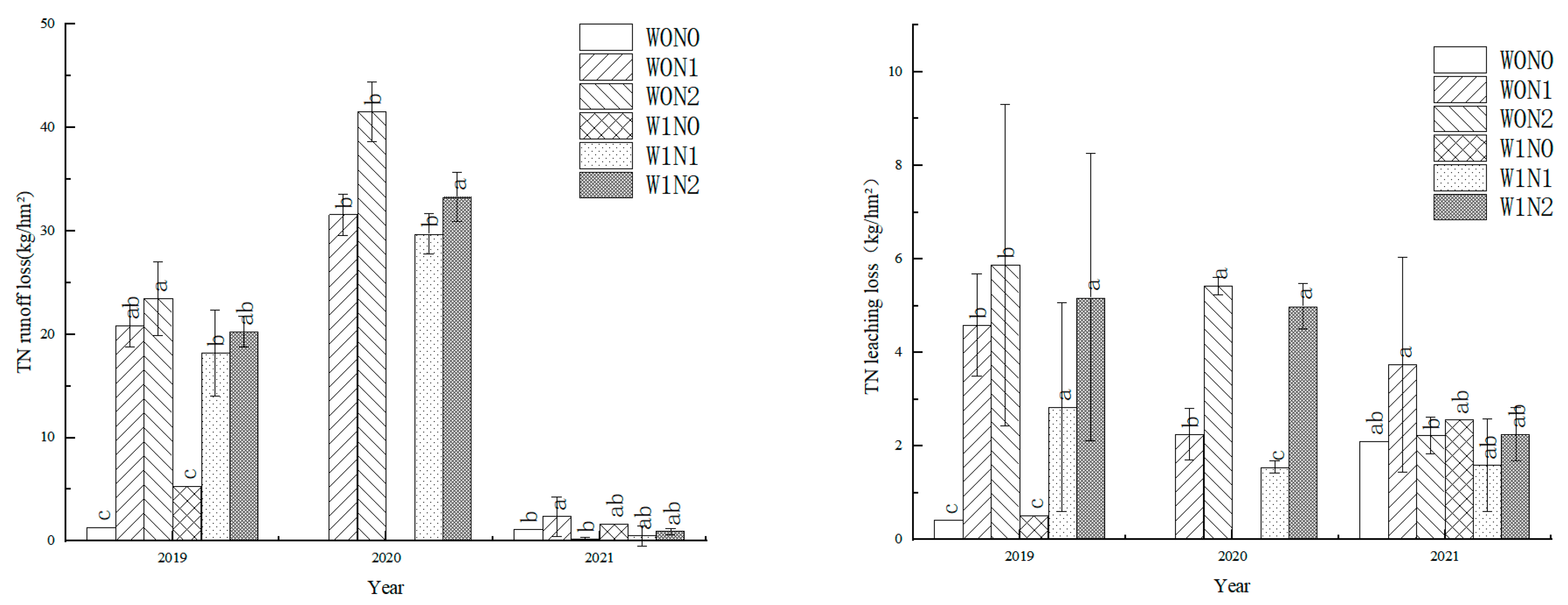
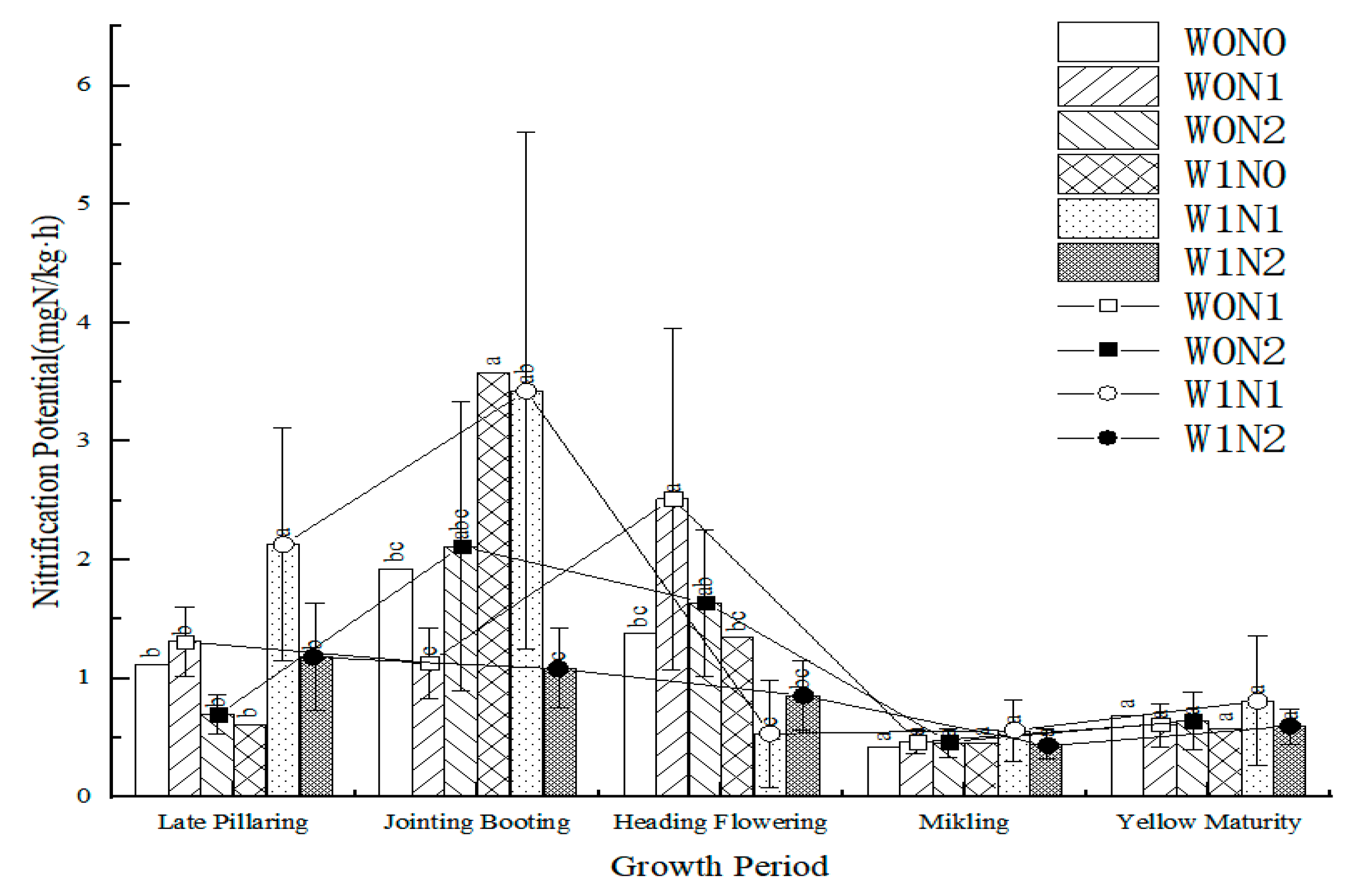
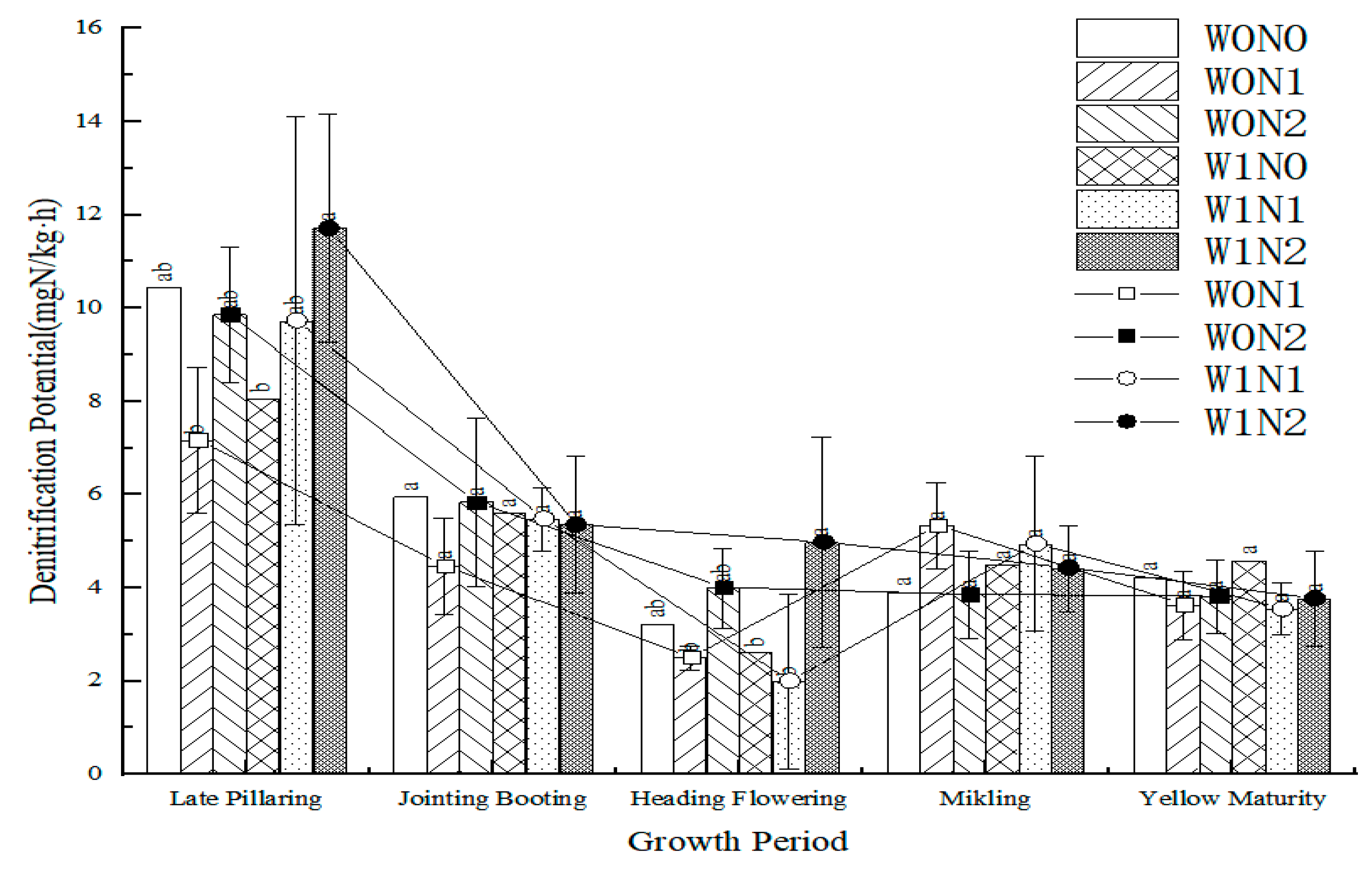
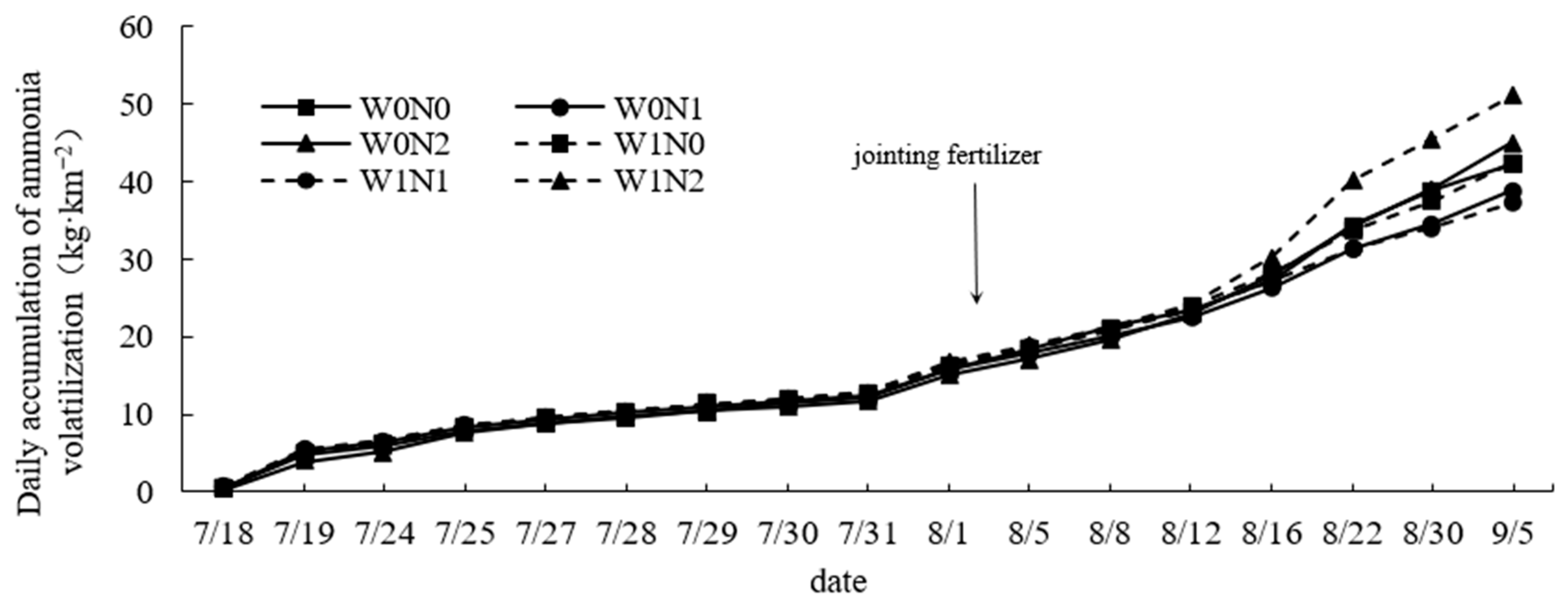
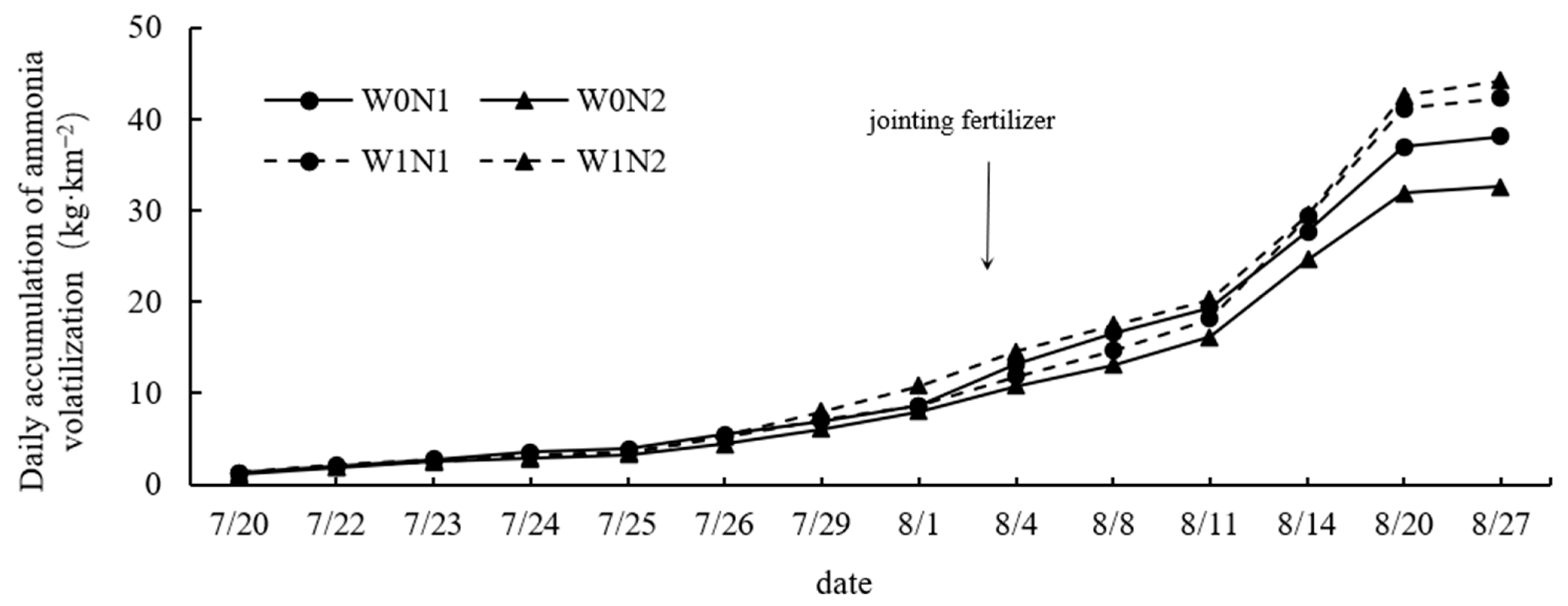
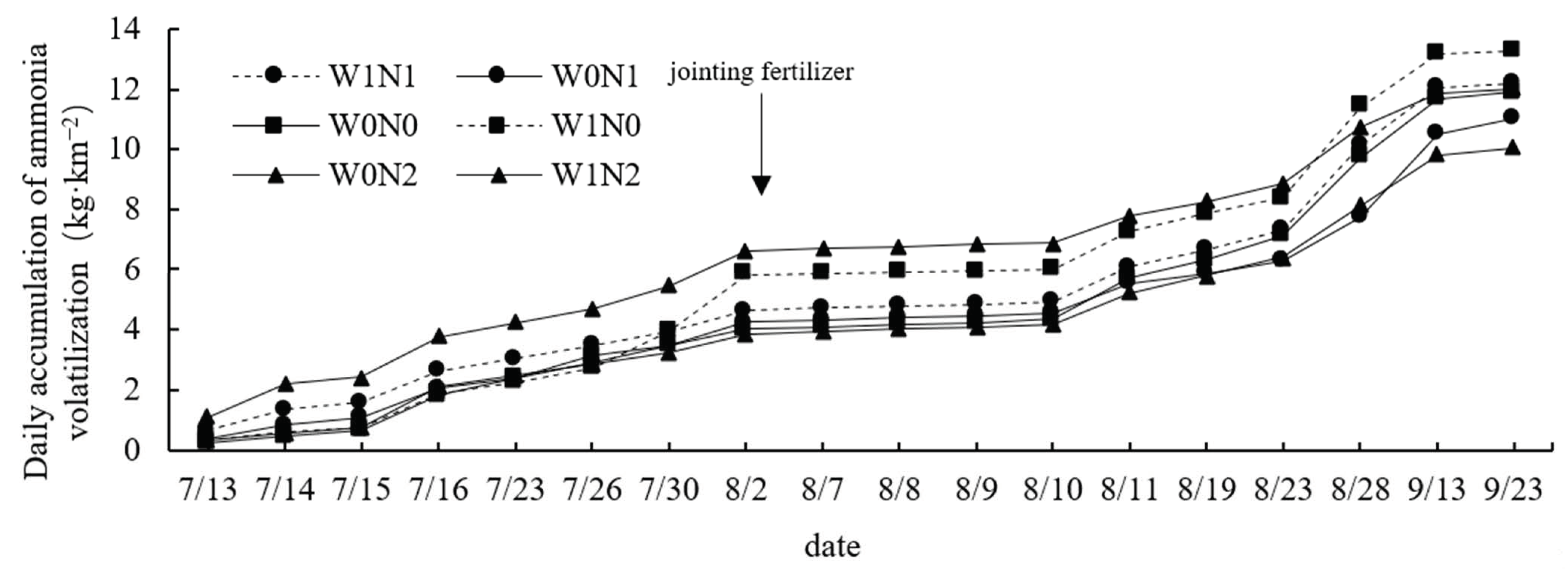
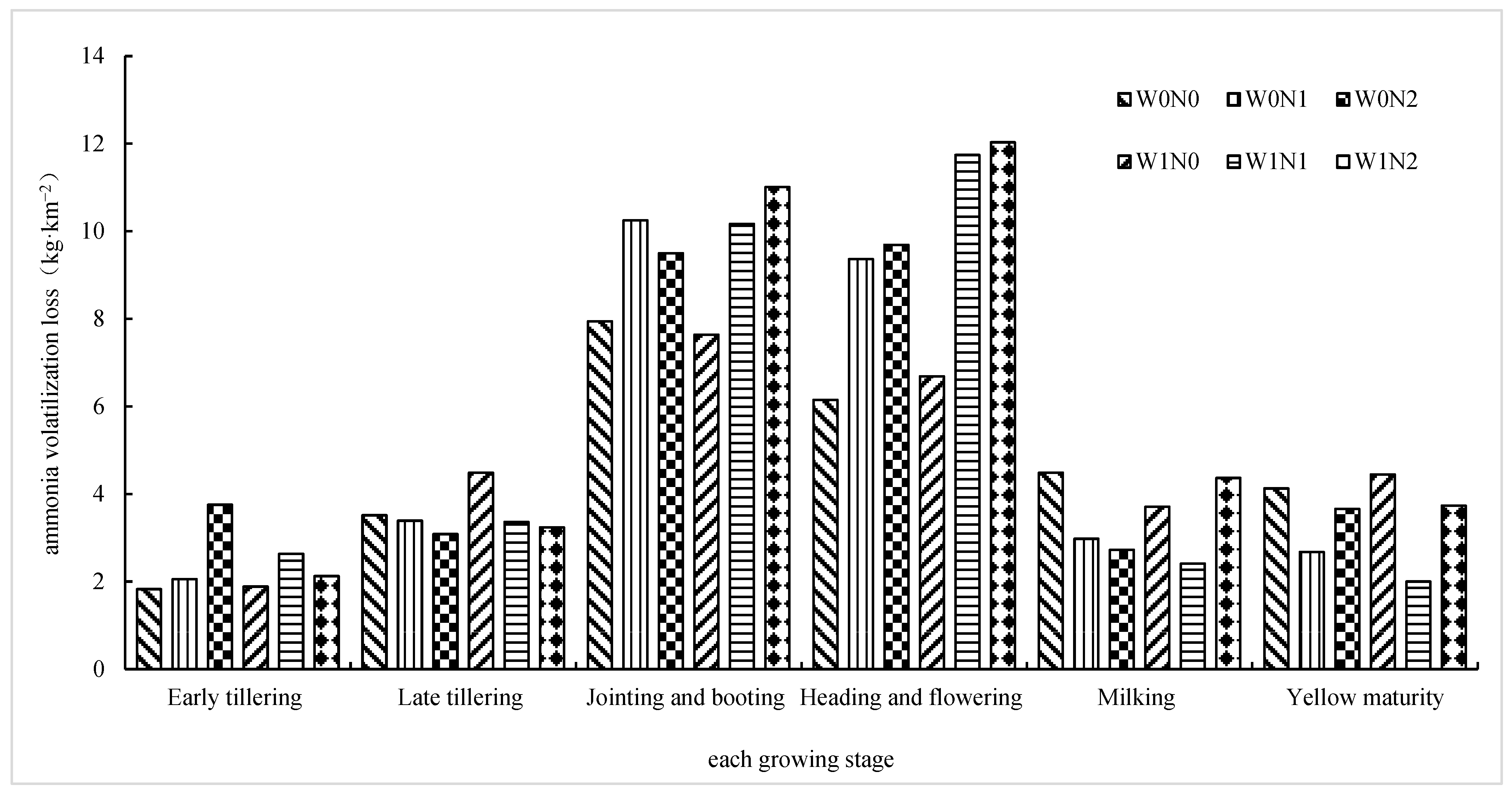

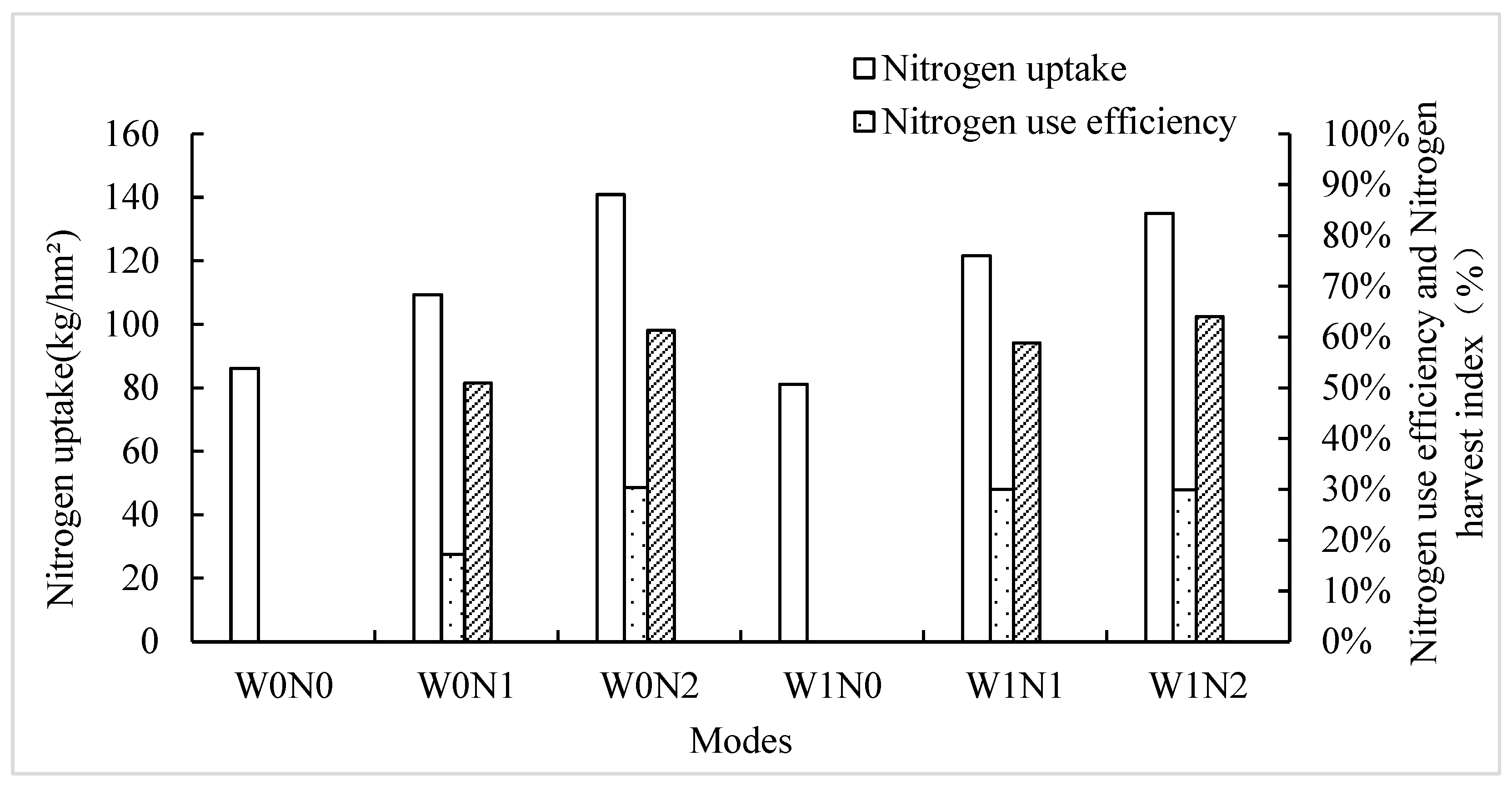
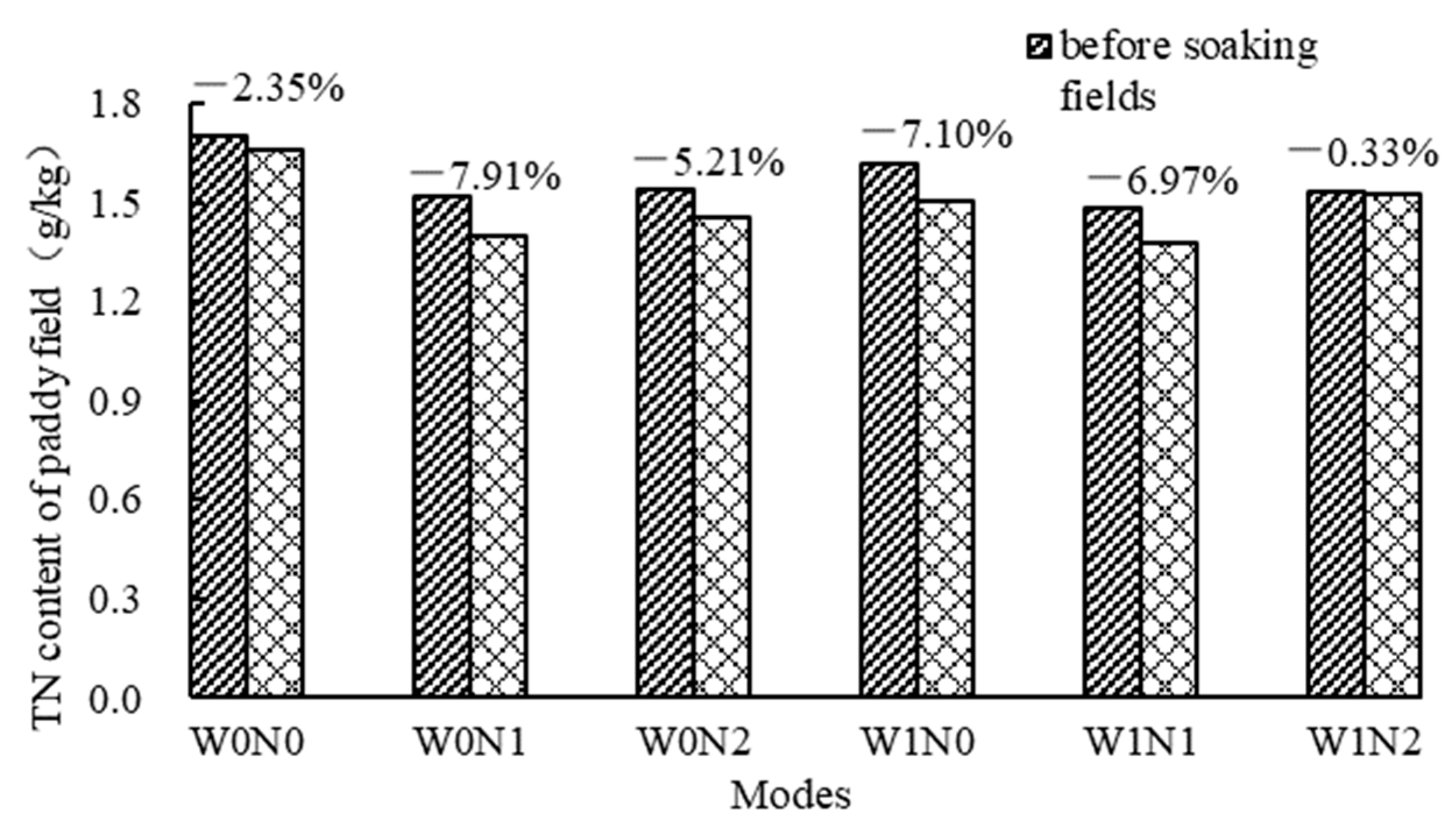
| Irrigation Mode | Lower Limit before Irrigation—Upper Limit after Irrigation—The Upper Limit of Rain Storage | ||||||
|---|---|---|---|---|---|---|---|
| Return Green (mm) | Early Tillering (mm) | Late Tillering (mm) | Jointing and Booting (mm) | Heading and Flowering (mm) | Milking (mm) | Yellow Maturity (mm) | |
| Intermittent irrigation (W1) | 0-20-30 | 0-20-50 | 0-20-50 | 0-20-50 | 0-20-50 | 0-20-50 | 0-20-30 |
| Dry 4 days | Later exposing field | Exposing field 4 days | Exposing field 4 days | Exposing field 4 days | Later natural drying | ||
| Flooding irrigation (W0) | 0-40-40 | 20-50-50 | 20-50-50 | 20-50-50 | 20-50-50 | 20-50-50 | 0-30-30 |
| Later exposing field | Later natural drying | ||||||
| Fertilization System | Treatment | 46% Urea (kg) | 15% Calcium Magnesium Phosphate Fertilizer (kg) | 60% Potassium Chloride (kg) | Number of Repeats |
|---|---|---|---|---|---|
| Base fertilizer | W0N0 | 0 | 1.260 | 0.315 | 1 |
| W1N0 | 0 | 1.260 | 0.315 | 1 | |
| W0N1 | 0.411 | 1.671 | 0.630 | 3 | |
| W1N1 | 0.411 | 1.671 | 0.630 | 3 | |
| W0N2 | 0.548 | 1.671 | 0.630 | 3 | |
| W1N2 | 0.548 | 1.671 | 0.630 | 3 | |
| Tillering fertilizer | W0N0 | 0 | 0 | 0 | 1 |
| W1N0 | 0 | 0 | 0 | 1 | |
| W0N1 | 0.247 | 0 | 0 | 3 | |
| W1N1 | 0.247 | 0 | 0 | 3 | |
| W0N2 | 0.329 | 0 | 0 | 3 | |
| W1N2 | 0.329 | 0 | 0 | 3 | |
| Panicle fertilizer | W0N0 | 0 | 0 | 0.385 | 1 |
| W1N0 | 0 | 0 | 0.385 | 1 | |
| W0N1 | 0.164 | 0 | 0.385 | 3 | |
| W1N1 | 0.164 | 0 | 0.385 | 3 | |
| W0N2 | 0.219 | 0 | 0.385 | 3 | |
| W1N2 | 0.219 | 0 | 0.385 | 3 |
| Year | 2019 | 2020 | 2021 | |
|---|---|---|---|---|
| Growth stage | Return Green | 18 June–24 June | 16 June–23 June | 27 June–7 July |
| Early Tillering | 25 June–9 July | 24 June–7 July | 8 July–18 July | |
| Late Tillering | 10 July–22 July | 8 July–23 July | 19 July–4 August | |
| Jointing and Booting | 23 July–5 August | 24 July–12 August | 5 August–22 August | |
| Heading and Flowering | 6 August–19 August | 13 August–23 August | 23 August–8 September | |
| Milking | 20 August–27 August | 24 August–10 September | 9 September–18 September | |
| Yellow Maturity | 27 August–17 September | 11 September–24 September | 19 September–9 October | |
| Rice transplanting date | 18 June | 16 June | 27 June | |
| Rice Harvest Dates | 17 September | 24 September | 9 October | |
| Total days of the growth period | 92 d | 101 d | 105 d | |
| Fertilization | Base fertilizer | 17 June | 15 June | 27 June |
| Tillering fertilizer | 1 July | 27 June | 8 July | |
| Panicle fertilizer | 23 July | 21 July | 4 August | |
| Years | Treatment | Precipitation (mm) | Irrigation (mm) | Recharge (Precipitation + Irrigation) (mm) | Drainage (mm) | Consumption (mm) | Leakage (mm) | Evapotranspiration (mm) | Discharge (Drainage + Consumption) (mm) |
|---|---|---|---|---|---|---|---|---|---|
| 2019 | W0N0 | 225.9 | 498.0 a | 674.0 | 164.9 a | 554.6 a | 104.3 d | 450.3 | 719.5 |
| W0N1 | 518.9 a | 669.8 | 154.5 ab | 675.6 ab | 149.7 c | 525.9 | 830.1 | ||
| W0N2 | 510.9 a | 683.1 | 125.9 b | 717.2 a | 172.1 ab | 545.1 | 843.1 | ||
| W1N0 | 345.2 c | 436.0 | 150.8 ab | 539.0 ab | 158.8 bc | 380.2 | 689.8 | ||
| W1N1 | 360.4 c | 480.4 | 124.8 b | 607.7 b | 183.6 a | 424.1 | 732.5 | ||
| W1N2 | 388.7 b | 562.0 | 93.2 c | 625.2 b | 165.3 abc | 459.9 | 718.4 | ||
| 2020 | W0N1 | 749 | 419.5 b | 1168.5 | 306.5 ab | 822.6 a | 205.1 ab | 617.5 | 1129.1 |
| W0N2 | 317.3 ab | 1066.3 | 333.8 b | 731.6 a | 202.7 b | 528.9 | 1065.4 | ||
| W1N1 | 289.4 a | 1038.4 | 278.8 ab | 743.9 a | 178.2 a | 565.7 | 1022.7 | ||
| W1N2 | 313.9 ab | 1062.9 | 258.2 a | 744.2 a | 173.8 ab | 570.4 | 1002.4 | ||
| 2021 | W0N0 | 451.4 | 482.1 ab | 933.5 | 85.4 a | 794.9a | 234.1 a | 560.8 | 880.3 |
| W0N1 | 386.2 ab | 837.6 | 65.3 a | 719.5 a | 238.5 a | 481.0 | 784.8 | ||
| W0N2 | 502.0 a | 953.4 | 83.2 a | 650.2 a | 193.9 b | 456.3 | 733.4 | ||
| W1N0 | 307.6 ab | 759.0 | 59.4 a | 649.8 a | 149.7 c | 500.1 | 709.2 | ||
| W1N1 | 354.0 b | 805.4 | 57.7 a | 618.0 a | 176.1 b | 441.9 | 675.7 | ||
| W1N2 | 331.0 ab | 782.4 | 85.1 a | 673.1 a | 188.4 b | 484.7 | 758.2 |
| Treatment | Yield in 2019/(kg/ha) | Yield in 2020/(kg/ha) | Yield in 2021/(kg/ha) |
|---|---|---|---|
| W0N0 | 394.37 b | - | 473.75 bc |
| W0N1 | 507.47 ± 91 a | 396.58 ± 32 bc | 572.79 ± 30 ab |
| W0N2 | 538.89 ± 10 a | 383.67 ± 22 c | 561.96 ± 19 ab |
| W1N0 | 382.72 b | - | 439.41 ± c |
| W1N1 | 535.38 ± 12 a | 462.30 ± 14 ab | 590.41 ± 125 a |
| W1N2 | 541.35 ± 25 a | 498.53 ± 82 a | 620.07 ± 48 a |
| W | 0.834 ns | <0.001 ** | 0.119 ns |
| N | <0.001 ** | <0.001 ** | <0.001 ** |
| W × N | <0.001 ** | <0.001 ** | <0.001 ** |
| Input | Output | |||||||||||||||
|---|---|---|---|---|---|---|---|---|---|---|---|---|---|---|---|---|
| Modes | The Application Amount of Fertilizer (kg/ha) | Mineralization (kg/ha) | Wet Deposition (kg/ha) | Irrigation (kg/ha) | Total (kg/ha) | Nitrogen Uptake by Rice (kg/ha) | Proportion (%) | Drainage (kg/ha) | Proportion (%) | Leaching Loss (kg/ha) | Proportion (%) | NH3 Volatilization (kg/ha) | Proportion (%) | Denitrification (kg/ha) | Proportion (%) | Total (kg/ha) |
| W0N0 | 0 | / | 5.1 | 0.18 | 86.14 | 76.4 | 1.68 | 1.49 | 1.35 | 1.2 | 23.58 | 20.91 | / | |||
| W0N1 | 135 | 24.8 | 7.2 | 2.02 | 169.02 | 109.3 | 60.87 | 39.79 | 22.15 | 5.80 | 3.23 | 24.61 | 13.70 | 0.07 | 0.04 | 179.6 |
| W0N2 | 180 | 27.8 | 9.3 | 2.85 | 219.93 | 140.8 | 78.42 | 30.13 | 16.78 | 9.27 | 5.16 | 25.19 | 14.03 | 0.09 | 0.03 | 205.49 |
| W1N0 | 0 | / | 4.6 | 1.64 | 81.11 | 73.16 | 2.76 | 2.49 | 3.11 | 2.80 | 23.88 | 21.54 | / | |||
| W1N1 | 135 | 33.7 | 8.6 | 3.33 | 180.61 | 121.6 | 67.71 | 28.66 | 15.96 | 3.71 | 2.07 | 25.43 | 14.16 | 0.06 | 0.05 | 179.49 |
| W1N2 | 180 | 34.7 | 7.8 | 2.04 | 224.52 | 134.9 | 75.12 | 24.47 | 13.62 | 11.72 | 6.53 | 26.52 | 14.77 | 0.08 | 0.04 | 197.71 |
| Different Effects | Water Saving | Emission Reduction | Fertilizer Utilization Rate | Yield |
|---|---|---|---|---|
| The amplitude of variation | 27.54% | 25.67% | 8.59% | 11.82% |
Disclaimer/Publisher’s Note: The statements, opinions and data contained in all publications are solely those of the individual author(s) and contributor(s) and not of MDPI and/or the editor(s). MDPI and/or the editor(s) disclaim responsibility for any injury to people or property resulting from any ideas, methods, instructions or products referred to in the content. |
© 2023 by the authors. Licensee MDPI, Basel, Switzerland. This article is an open access article distributed under the terms and conditions of the Creative Commons Attribution (CC BY) license (https://creativecommons.org/licenses/by/4.0/).
Share and Cite
Luo, W.; Li, Y.; Yang, Z.; Wang, Y.; Chen, J.; Xiao, X.; Chen, Y.; Wei, C.; Zou, Z. Water and Nitrogen Balance under Various Water and Fertilizer Regulation Modes. Agronomy 2023, 13, 2870. https://doi.org/10.3390/agronomy13122870
Luo W, Li Y, Yang Z, Wang Y, Chen J, Xiao X, Chen Y, Wei C, Zou Z. Water and Nitrogen Balance under Various Water and Fertilizer Regulation Modes. Agronomy. 2023; 13(12):2870. https://doi.org/10.3390/agronomy13122870
Chicago/Turabian StyleLuo, Wenbing, Yalong Li, Zirong Yang, Yan Wang, Jialong Chen, Xin Xiao, Yanfei Chen, Chenchen Wei, and Zhike Zou. 2023. "Water and Nitrogen Balance under Various Water and Fertilizer Regulation Modes" Agronomy 13, no. 12: 2870. https://doi.org/10.3390/agronomy13122870





